Day 1 Shanghai → Budapest → Kecskemét → Szeged (Hungary)
All day
丨Intermodal description:
This itinerary features Shanghai Airlines, which offers nationwide connecting flights. If your city has flights from these airlines to Pudong International Airport, we can arrange connecting flights for your outbound and return journeys. For reference, the following routes are available: Outbound: Beijing Capital → Shanghai Pudong → Budapest; Return: Budapest → Shanghai Pudong → Beijing Capital. The connecting fares are subject to your inquiry with the airline, but the recommended round-trip fares range from 500 to 800 RMB.
丨 Full refund if visa is rejected:
How to cancel the visa:
After the trip, you need to collect your passport and round-trip boarding passes and send them to the consulate for visa cancellation. This is expected to take about half a month. Please arrange your itinerary after returning home.
About the team:
This trip is a China-TravelNote independent tour, with a maximum of 25 people. A China-TravelNote tour leader will be arranged upon completion of the trip.
·morning
Since the flight is at 1:50 am, please arrive at Shanghai Pudong International Airport 1 day in advance, 3 hours before the flight takes off, check in, and take the flight to Budapest. The five Balkan countries on this trip are: Croatia, Slovenia, Bosnia and Herzegovina, Serbia, and Hungary.
Reference flights:
Flight FM869, Shanghai Pudong International Airport (PVG) - Budapest Ferenc Liszt International Airport (BUD), 01:50 - 08:05, flight time: 11 hours and 15 minutes, daylight saving time difference: 6 hours
Upon arrival, we arrange for airport pickup and start the tour.
We will drive to Kecskemét, a paradise of Art Nouveau, which is rarely visited by domestic and foreign tourists, but it is one of the most worthwhile places to visit in Hungary.
We arrived at the [Central Square]. The first thing that will attract you at first sight must be the Town Hall, which stands proudly on the main square of Kecskemét and is named after the national hero Lajos Kossuth.
There is an elegant [White Church] on the square. It was formerly a synagogue and was built in 1864 in Moorish style.
At noon we arranged for everyone to enjoy Hungarian national stew
·afternoon
After lunch we drove to Szeged, the third largest city in Hungary and a Central European city that is underestimated and ignored by tourists. Most of the attractions here can be traced back to the late 19th and early 20th centuries (the period when Central European cities really flourished).
We will explore this beautiful city in the form of a city walk. When we arrive in Szeged, you will be deeply impressed by the [Szeged Synagogue]. This monumental building (one of the largest buildings in Hungary) is designed in Art Nouveau style with a touch of exotic colors. It is a treasure in the history of architecture.
The local Town Hall features a Neo-Gothic design, but still retains some Art Nouveau details. Szeged is renowned for its religious architecture. Besides the aforementioned synagogue, the most famous of its other churches is the Cathedral of Our Lady of Hungary. Standing tall in Cathedral Square, this church is the fourth largest in Hungary and a symbol of Szeged.
[Szechenyi Square] is the central square of Szeged. Sit in an open-air cafe, drink coffee, and enjoy the beautiful weather and the vibrant atmosphere that students bring to the city.
The trip ended early that night and everyone checked into the hotel to rest and adjust to the jet lag.


Day 2 Szeged → Zemun → Belgrade (Serbia)
·morning
Today we will enter Serbia, the quietly beating "Heart of Europe", where the ancient and the modern are intertwined to create an unforgettable journey.
Upon entering Serbia, we'll first visit Zemun, a fairytale town plucked from the lingering dreams of the Austro-Hungarian Empire. Climbing the Gadosta, we'll gaze out over the river and the town, its cobblestone alleys and red-roofed, sloping houses – you'll understand what it means to "stand still in time."
We will then travel to the capital, Belgrade, to visit the ruins of the Chinese Embassy. On May 7, 1999, the Chinese Embassy in the heart of Belgrade was bombed, tragically killing three Chinese journalists. To commemorate this event, the Belgrade City Government erected a memorial plaque in front of the bombed embassy site, which will remain permanently for public viewing.
·afternoon
After lunch, we continue our tour of the vibrant capital. The magnificent Cathedral of Saint Sava (inside) is clearly visible from all corners of the city, its dome dominating the landscape. It's actually one of the largest churches in the world, often compared to Istanbul's Hagia Sophia (for its shape) or Barcelona's Sagrada Familia (as neither is fully completed).
Afterwards, we'll visit the Tito Mausoleum (inside), the final resting place of the legendary Yugoslav leader, Josip Broz Tito. Tito, a keen gardener, wished to be buried in his beloved greenhouse, hence the mausoleum's nickname: "The Greenhouse." Today, it serves not only as his final resting place but also as a museum combining memorials and exhibitions. Displays include Tito's personal belongings, his marshal's uniform, and gifts from dignitaries from around the world, telling the story of that era.
Finally, we'll stroll to Kalemegdan Fortress (inside). This ancient fortress, overlooking the confluence of the Danube and Sava rivers, is one of Belgrade's most iconic landmarks. Not only does it boast a rich history and magnificent views, it's also one of the city's most ideal spots for strolling, relaxing, and taking photos. In the fading light of the setting sun, the fortress's stone walls tell of a millennium's past, silently watching over this city that never sleeps.


Day 3 Belgrade → Wooden Village → Zlatibor (Serbia)
·morning
Early this morning, we will head to southern Serbia, to a place known as "paradise on earth".
·afternoon
Our destination is [Wood Village (Inside)], a village that feels like something out of a fairytale. Every building here is made of wood, preserving its original style, making it feel like stepping into an ancient Serbian village. Although small, the village is fully equipped with amenities, including a church, restaurant, bar, cinema, library, and basketball court.
Although the Wooden Village was created by the famous director Emil Kusturica for the filming of the movie "Life is a Miracle", it is also a folk village full of life, allowing tourists to experience the leisurely life in the western countryside of Serbia.
After our visit to the wooden village, we'll experience the "Figure 8 Train," the world's only narrow-gauge train still in operation, making it one of Serbia's most unique ways to explore. The train retains its original all-wooden structure, steam locomotive, and green hull, creating a truly retro experience. Enjoy the fresh air and breathtaking views of the beautiful, tranquil mountain scenery aboard this retro train.


Day 4 Zlatibor → Visegrad → Sarajevo (Bosnia and Herzegovina)
·morning
Today we'll visit the third country on our journey, Bosnia and Herzegovina. Located on the Serbia-Bosnia border, Dobrun Monastery boasts a tranquil and historic monastery. Dating back to the 14th century, the monastery is not only a significant landmark of the Eastern Orthodox faith but also a vibrant religious site to this day.
After the tour, we arrived in Visegrad. Low-rise houses surrounded by mountains and rivers create a tranquil scene. The Mehmed Pasha Sokolovich Bridge, designated a UNESCO World Heritage Site in 2007, has become Visegrad's signature attraction.
·afternoon
Arriving in Sarajevo in the afternoon, it felt like stepping into an open-air museum at the intersection of civilizations. The Latin Bridge, a stone arch bridge bearing the weight of history, spans the Miljac River. It's not only a Sarajevo landmark, but also a witness to world history. It's famous for being the site of the 1914 Sarajevo Massacre, the ignition point of World War I. Standing on the bridge, one can hear the echoes of history and feel the day that changed the world.
We will stroll through the Baščarhia Bazaar, Sarajevo's most charming historical district. The narrow cobblestone streets are lined with traditional handicraft shops, cafes and copper workshops, as if still stuck in the afterglow of the Ottoman era.
In Sarajevo, you can savor a piece of history in a cup of strong Turkish coffee and hear the bells of four religions chime in a single street. Here, there are scars and hope; there is both a setting sun and a future.
At the same time, if the weather is good, we also recommend you to see the panoramic view of the city at [Huangbao]. However, the terrain here is high, so you need to walk there.


Day 5 Sarajevo → Mostar → Dubrovnik (Croatia)
·morning
After breakfast, we will drive to Mostar, the most charming ancient city in southern Bosnia and Herzegovina. This city is famous for its bridge and its history.
Arriving at the iconic Old Bridge in Mostar, we felt like stepping into a moving painting. Spanning the emerald green Neretva River, its red-tiled stone walls reflected in the water create a breathtaking beauty. Mostar, meaning "Bridge Keeper," is a name that means "bridge keeper." Built by the Ottoman Empire in the 16th century, this arched bridge stood for 427 years until it was destroyed during the Bosnian War in 1993. Rebuilt in 2004, it is now a UNESCO World Heritage Site. Standing on the bridge, you can not only overlook the magnificent river valley, but also feel the city's strength in its rebirth after war.
Strolling along the bridge, we'll delve into Mostar's Old Bazaar, one of the city's oldest districts, still retaining its 16th-century Ottoman charm. Its cobblestone streets are lined with traditional coppersmiths, carpet vendors, and Turkish cafes, while the air is filled with the aroma of spices and grilled meats. Once the commercial hub of southern Bosnia, it boasted over 500 workshops at its peak and remains a haven for artisans.
At noon, we specially arrange to enjoy an authentic barbecue meal, so that your taste buds can also feel the warmth of Central Europe.
·afternoon
After lunch, we set off for Croatia and arrived at Dubrovnik, a city that was highly recommended by both "Flowers in the Sky" and "Game of Thrones". We were tired from the long journey, so we did not plan any further itinerary in the afternoon and everyone checked into the hotel to have a good rest.
If you arrive in Ducheng early, you can also take public transportation or taxi to explore the old town freely.


Day 6 Dubrovnik
·morning
Welcome to Dubrovnik, a charming ancient city nestled on the Adriatic Sea, known as the "Pearl of the Adriatic." Game of Thrones has made this city famous again!
In the morning, we'll ascend the magnificent Old City Walls. This nearly 2-kilometer-long wall, built along the coastline and surrounding the ancient city, offers panoramic views of the azure Adriatic Sea and the red-tiled roofs of the ancient city. This area was also a filming location for the TV series "King's Landing." Strolling through it will feel like stepping into the epic world of the series.
Then, journey into the heart of this UNESCO World Heritage city—the Old Town—for a journey back in time to the Middle Ages. The old town is dotted with historic buildings of varying styles, including the 18th-century reconstruction of the Dubrovnik Cathedral (exterior), whose Baroque dome and pristine white stone walls gleam in the sunlight. The Governor's Palace (exterior), another landmark, was built in 1435 and once served as the office and residence of the Governor of the Republic of Ragusa. Today, its majestic and elegant architecture speaks to the Republic's glorious past.
·afternoon
After the tour, you will have free time to explore the city on your own.
Whether you are enjoying a cup of authentic Croatian coffee in the alleys of the city, walking into hidden bookstores and art shops, or strolling along the seaside boardwalk and feeling the gentle sea breeze;
You can also take the cable car to the top of the mountain to overlook the entire city, or go to Lovrijenac Fortress to appreciate the magnificent view of King's Landing from a different angle.


Day 7 Dubrovnik → Split → Zadar
·morning
After breakfast, we bid farewell to Dubrovnik and drove to Split, the second largest city in Croatia. Known as the "Palace City on the Adriatic Sea", it is a model of the fusion of ancient Rome and Mediterranean style.
We will visit the core attraction - [Diocletian's Palace]. This magnificent palace built by the ancient Roman emperor in the 3rd century AD is now integrated with modern urban architecture, forming a rare "living monument" in the world.
Strolling through the palace corridors, sunlight streams through the cracks between the stone pillars, and you can almost hear the echoes of ancient gladiators. Don't forget to stop by Peristil Square to experience the intersection of antiquity and modernity.
·afternoon
After a Chinese lunch, we will head to the charming coastal ancient city of Zadar, a low-key yet charming city with over 3,000 years of history.
We will visit the unique exteriors of St. Donat's Church and Zadar Cathedral and experience the rich historical atmosphere.
Next, we visited the Sea Organ and Sunshine Tribute, two of the most popular modern landmarks. Here, waves propel hidden pipes along the shore, creating a wondrous symphony of nature and architecture. At sunset, light and shadow dance across the water and glass installations, as if the sea were whispering to the sun.
On this day, from the classical echoes of Split to the seaside melodies of Zadar, we will embark on a wonderful tour of the two cities between time and nature.


Day 8 Zadar → Zagreb → Ljubljana (Slovenia)
·morning
After breakfast we drive to Zagreb, the capital and largest city of Croatia.
We'll first stroll through Zagreb's Old Town and admire the majestic twin-towered Zagreb Cathedral (exterior). This Gothic-style structure is the tallest building in Croatia and an instantly recognizable symbol of the city. St. Mark's Church (exterior), with its mosaic roof featuring both the coat of arms of the Kingdom of Croatia and the city of Zagreb, vividly captures the country's history and glory.
If time permits, we will also visit the Red Umbrella Market, one of the landmarks of local life. The stalls here are neatly arranged under large red and white umbrellas. A wide variety of fresh fruits and vegetables, flowers and authentic handicrafts are interwoven in the sunshine to form a vivid market picture. It is an ideal way to understand the daily life of Zagreb.
·afternoon
After lunch, we headed to Ljubljana, the capital of Slovenia. This small, artistic city is known as "Central Europe's Loveliest Capital." Interestingly, "Ljubljana" is pronounced similarly to "dear" in Slovenian, giving it the romantic nickname of "City of Love."
Upon arrival, we'll explore Ljubljana's historic district, including the Town Hall (exterior view). This historic building, located in the city square and still serving as the seat of government, boasts rich Renaissance and Baroque architecture. We'll then visit two landmarks: the Dragon Bridge and the Triple Bridge. The four bronze dragons guarding the Dragon Bridge are a symbol of the city, while the Triple Bridge, consisting of a main bridge and two side bridges, spans the Ljubljanica River and is one of the city's most picturesque pedestrian bridges.
We'll then take a cable car up to Ljubljana Castle (cable car ticket included). Built in the 11th century, this ancient castle blends Romanesque, Gothic, and Renaissance architectural styles, and bears witness to Slovenia's millennia of history. From the observation tower, you'll have panoramic views of the entire city and the distant mountains. Ljubljana's nightscape is truly captivating, a perfect end to the day.
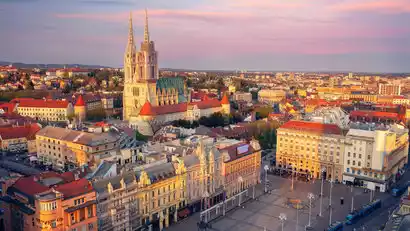
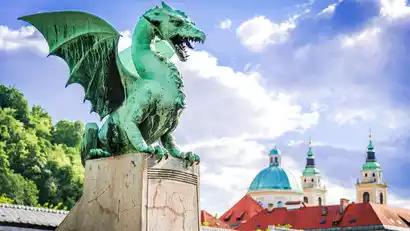
Day 9 Ljubljana → Lake Bled → Lake Balaton (Hungary)
·morning
After bidding farewell to Ljubljana, the capital full of humanistic atmosphere, we will head north to Slovenia's fascinating natural destination - Lake Bled, and begin a pure journey back to nature.
When we arrived at the lake, the view suddenly opened up - Lake Bled was like an emerald inlaid at the foot of the Alps. The water was crystal clear and the lake was surrounded by lush forests and towering snow-capped peaks.
We'll board a traditional wooden boat and slowly paddle to a small island in the middle of the lake, feeling the gentle waves and the gentle breeze. Once on the island, we'll visit the Church of the Assumption, one of Slovenia's most romantic churches and a popular spot for couples to make vows.
In the distance on the shore, you can see Bled Castle built on the mountain. It stands quietly on the cliff. It is one of the oldest castles in Slovenia. It was built in the 11th century and was once a defensive fortress and aristocratic residence.
·afternoon
On this day, we will slowly withdraw from the historical trajectory of the city and completely immerse ourselves in the mountains and rivers.
We will arrive in Hungary in the afternoon and arrange for everyone to stay in a hotel near Lake Balaton.
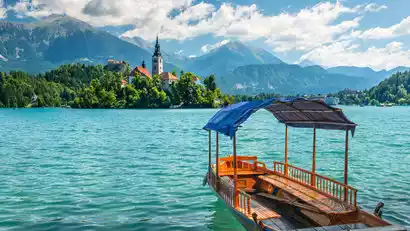
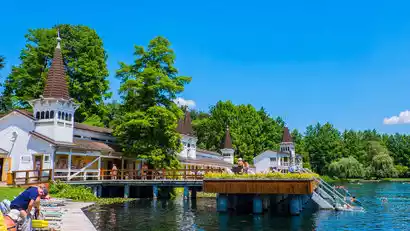
Day 10 Lake Balaton → Budapest (Hungary)
·morning
Today we officially entered the rural lake area of Hungary and came to the Lake Balaton area, a naturally formed lake with clear turquoise water, known as the "Hungarian Sea". The towns and villages along the lake retain many ancient buildings and traditional culture.
We then traveled to the small town of Tihany, nestled north of Lake Balaton. Nestled on the lakeside plateau, it boasts a thousand-year-old monastery and breathtaking views. Summer is particularly noteworthy, marking Tihany's lavender season. During this time, the town is transformed into a vibrant purple dreamscape by vast fields of blooming lavender, filling the air with a refreshing fragrance. Strolling through the area, you'll feel like you're in Provence, southern France.
At noon, we will enjoy authentic Hungarian cuisine at the Tihany Lake View Restaurant. While savoring the food, we will admire the picturesque lake view outside the window, adding a touch of beauty and leisure to today's journey.
·afternoon
Arrived in Budapest in the afternoon. The itinerary of Budapest is up to everyone to DIY. Tonight the hotel has been upgraded to a five-star hotel.
Recommended free activities:
1. Fisherman's Bastion: Fisherman's Bastion is a Neo-Gothic and Neo-Romanesque-style observation deck located on Castle Hill on the Buda side of the Danube River, near Matthias Church. From its tower and observation deck, you can see panoramic views of the Danube, Margaret Island, Pest to the east, and Gellert Hill.
2. [Chain Bridge Stroll]: Stroll across the Chain Bridge, connecting Buda and Pest, and experience the unique charm of the city, especially at night, when the lights on the bridge add a touch of romance.
3. [Hungarian Central Market]: The Hungarian Central Market is the largest indoor market in Budapest. It is located on the Pest side of the Liberty Bridge and offers a variety of traditional Hungarian food, souvenirs and handicrafts.
4. Danube River Cruise: Experience a unique way to explore Budapest and admire breathtaking views of the city from the water. The cruise passes iconic landmarks like Buda Castle, the Chain Bridge, and the Hungarian Parliament Building. At sunset and at night, the river lights illuminate the city, creating a dreamlike spectacle.
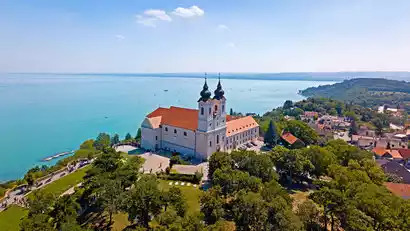
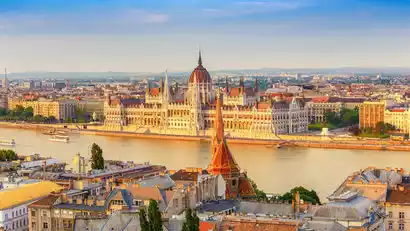
Day 11 Budapest → Shanghai
All day
Today, we will end our trip to the five Balkan countries. We will arrange airport drop-off, handle tax refund and boarding procedures for you at the appropriate time, and then take your flight back to China!
Reference flights:
Flight FM870, Budapest Ferenc Liszt International Airport (BUD) - Shanghai Pudong International Airport (PVG), 12:30 PM - 5:40 AM (+1), duration: 11 hours and 10 minutes
Day 12 Arrival in Shanghai
All day
Today is disbandment day
We expect to arrive in Shanghai at 5:40, officially ending our journey. We look forward to your travel notes.
Due to regulations, all European embassies have a (though not very) chance of requiring applicants to attend an interview at the embassy after their return. If this happens, please understand and cooperate, and attend the interview within the designated timeframe to avoid impacting future visa applications. Travel and accommodation expenses incurred during the interview are the responsibility of the applicant.
The visa cancellation time for relevant European countries is usually around 15 working days. When you sign up for a tour, please pay attention to your other exit arrangements after returning to China.








